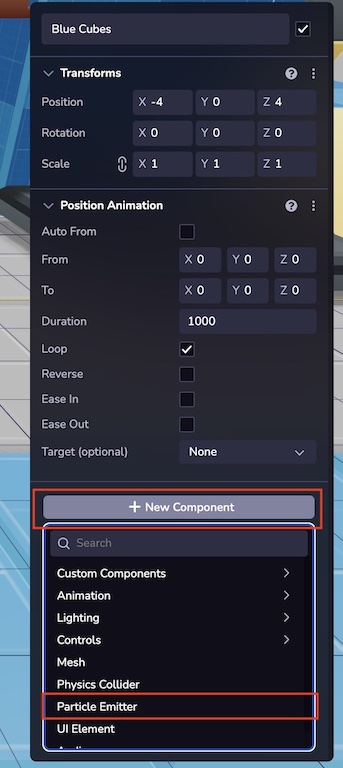Partículas
Introducción
Las partículas son una potente herramienta para añadir efectos dinámicos y llamativos a cualquier escena. Aportan vida y movimiento, creando desde elementos ambientales realistas como humo, fuego y lluvia hasta efectos estilizados como magia, chispas o explosiones. Utilizadas de forma sutil o dramática, las partículas realzan la atmósfera y la interactividad de una escena, haciendo que las experiencias sean más cautivadoras y visualmente más ricas.
Añadir partículas
Las partículas pueden añadirse a la entidad a través de la interfaz de Studio o en código. Para añadirlos en Studio, pulse el botón "Nuevo componente".


Ejemplo
El siguiente ejemplo muestra cómo añadir un ParticleEmitter a una entidad en tiempo de ejecución.
ecs.ParticleEmitter.set(world, component.eid, {
stopped: false,
emitterLife: 10,
particlesPerShot: 5,
emitDelay: 1,
minimumLifespan: 1,
maximumLifespan: 3,
mass: 1,
gravity: 1,
scale: 1,
forceX: 0,
forceY: 60,
forceZ: 0,
spread: 120,
radialVelocity: 0,
spawnAreaType: 'point',
resourceType: 'model',
resourceUrl: 'https://static.8thwall.app/assets/Moon-lowpoly-v3-yg6nmdc1uj.glb',
})
Emisión
Los atributos de emisión definen la forma en que las partículas se colocan en el mundo y algunos de los atributos globales que afectan a todas las partículas por igual.
- Detenido: Si está marcada, el emisor no emitirá.
- Vida útil del emisor: Define la vida útil del emisor.
- Partículas por disparo: Cuántas partículas se colocan cada vez que se dispara el emisor.
- Retardo entre emisiones: Retardo entre emisiones en segundos.
- Duración: Establece un rango que representa el tiempo que las partículas permanecen en la escena antes de desaparecer.
- Masa: La masa de cada partícula, sólo relevante cuando se simula física.
- Gravedad: Añade una fuerza hacia abajo que hace caer las partículas.
- Fuerzas: Fuerzas simples en los ejes relativos X, Y y Z que se aplican a cada partícula.
- Dispersión: Es el ángulo que se mueven las partículas en relación al emisor.
- Velocidad radial: Si se establece por encima de 0, el tipo de velocidad del emisor cambiará a radial. La velocidad radial se calcula con respecto al observador y las fuerzas vectoriales se ven influidas por la fuerza radial.
Tipo de zona de desove
Las zonas de generación cambian la coordenada inicial de las partículas.
- Punto: Spawn se establece en las coordenadas del emisor.
- Caja: Define una caja utilizando anchura, altura y profundidad.
- Esfera: Define un área de spawn de una esfera con un radio definido.
Estas áreas de spawn no funcionarán correctamente si las dimensiones se establecen en 0.
Tipo de zona límite
Las cajas delimitadoras dictan los límites espaciales dentro de los cuales se generan las partículas.
- Caja: Define una caja utilizando anchura, altura y profundidad.
- Esfera: Define un área de spawn de una esfera con un radio definido.
Estas zonas delimitadoras no funcionarán correctamente si las dimensiones son 0 o negativas. Si se utiliza el Área de generación, la zona delimitada debe ocupar un volumen mayor que el Área de generación.
Tipo de recurso
Este sistema es capaz de renderizar activos glb y sprites sencillos. Elige un modelo para 3D o un sprite para sprites 2D. Utilice una URL de acceso público para cargar el activo en el emisor.
- Sprites: Tienen opciones de fusión que funcionan de forma similar a los efectos de capa básicos de Photoshop. Son muy útiles para crear efectos visuales como fuego, estrellas o humo.
- Modelo: Modelos 3D con comportamiento de partículas. Útil para crear efectos volumétricos.
Simulación
Estos parámetros afectarán a la forma en que las partículas se comportan por sí mismas después de ser colocadas en el mundo.
- Color: Si los sprites se establecen como un tipo de recurso, entonces los sprites pueden cambiar de color. Introduzca un valor hexadecimal del color inicial y final para que se desplacen gradualmente.
- Deriva aleatoria: Las partículas derivarán aleatoriamente de acuerdo con el parámetro de rango de deriva aleatoria.
- Colisión: Si las partículas se acercan entre sí, se aplicará una fuerza opuesta entre ellas.
Ejemplos
Partículas iniciales
ecs.ParticleEmitter.mutate(world, component.eid, (cursor) => {
cursor.stopped = false
})
Detención de partículas
ecs.ParticleEmitter.mutate(world, component.eid, (cursor) => {
cursor.stopped = true
})
Modelos emisores
ecs.ParticleEmitter.set(world, component.eid, {
stopped: false,
resourceType: 'model',
resourceUrl: 'assets/robot.glb',
})